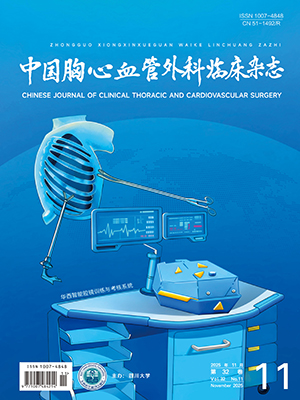| 1. |
Sung H, Ferlay J, Siegel RL, et al. Global cancer statistics 2020: GLOBOCAN estimates of incidence and mortality worldwide for 36 cancers in 185 countries. CA Cancer J Clin, 2021, 71(3): 209-249.
|
| 2. |
中华医学会肿瘤学分会, 中华医学会杂志社. 中华医学会肺癌临床诊疗指南(2022版). 中华肿瘤杂志, 2022, 44(6): 457-490.Oncology Society of Chinese Medical Association, Chinese Medical Association Publishing House. Chinese Medical Association guideline for clinical diagnosis and treatment of lung cancer (2022 edition). Chin J Oncol, 2022, 44(6): 457-490.
|
| 3. |
李思思, 张艳, 李宏洁, 等. 老年癌症患者共病的研究进展. 中国全科医学, 2020, 23(7): 880-883, 888.Li SS, Zhang Y, Li HJ, et al. Advances in research on comorbidities in elderly cancer patients. Chin Gen Pract, 2020, 23(7): 880-883, 888.
|
| 4. |
Zhu D, Ding R, Ma Y, et al. Comorbidity in lung cancer patients and its association with hospital readmission and fatality in China. BMC Cancer, 2021, 21(1): 557.
|
| 5. |
Albano D, Bilfinger T, Feraca M, et al. A multidisciplinary lung cancer program: does it reduce delay between diagnosis and treatment? Lung, 2020, 198(6): 967-972.
|
| 6. |
Patella M, Tessitore A, Cianfarani A, et al. Early outcome of anatomical lung resection for non-small cell lung cancer in the elderly. Eur Rev Med Pharmacol Sci, 2021, 25(16): 5129-5136.
|
| 7. |
Cihanbeylerden M, Yumrukuz M, Kurt B, et al. Effect of pulmonary functions on survival in patients with operable non-small cell lung cancer. J Coll Physicians Surg Pak, 2022, 32(5): 606-612.
|
| 8. |
中华医学会心血管病学分会, 中国康复医学会心肺预防与康复专业委员会, 中华心血管病杂志编辑委员会. 心肺运动试验临床规范应用中国专家共识. 中华心血管病杂志, 2022, 50(10): 973-986.Chinese Society of Cardiology, Chinese Medical Association, Professional Committee of Cardiopulmonary Prevention and Rehabilitation of Chinese Rehabilitation Medical Association, Editorial Board of Chinese Journal of Cardiology. Chinese expert consensus on standardized clinical application of cardiopulmonary exercise testing. Chin J Cardiol, 2022, 50(10): 973-986.
|
| 9. |
Charlson ME, Pompei P, Ales KL, et al. A new method of classifying prognostic comorbidity in longitudinal studies: development and validation. J Chronic Dis, 1987, 40(5): 373-383.
|
| 10. |
Birim O, Kappetein AP, Bogers AJ. Charlson comorbidity index as a predictor of long-term outcome after surgery for nonsmall cell lung cancer. Eur J Cardiothorac Surg, 2005, 28(5): 759-762.
|
| 11. |
Ha D, Ries AL, Lippman SM, et al. Effects of curative-intent lung cancer therapy on functional exercise capacity and patient-reported outcomes. Support Care Cancer, 2020, 28(10): 4707-4720.
|
| 12. |
Levett DZH, Jack S, Swart M, et al. Perioperative cardiopulmonary exercise testing (CPET): consensus clinical guidelines on indications, organization, conduct, and physiological interpretation. Br J Anaesth, 2018, 120(3): 484-500.
|
| 13. |
Brunelli A, Kim AW, Berger KI, et al. Physiologic evaluation of the patient with lung cancer being considered for resectional surgery: diagnosis and management of lung cancer, 3rd ed: American College of Chest Physicians evidence-based clinical practice guidelines. Chest, 2013, 143(5 Suppl): e166S-e190S.
|
| 14. |
Charlson ME, Carrozzino D, Guidi J, et al. Charlson comorbidity index: a critical review of clinimetric properties. Psychother Psychosom, 2022, 91(1): 8-35.
|
| 15. |
Su XE, Hong WP, He HF, et al. Recent advances in postoperative pulmonary rehabilitation of patients with non-small cell lung cancer (Review). Int J Oncol, 2022, 61(6): 156.
|
| 16. |
Okada S, Shimomura M, Ishihara S, et al. Clinical significance of postoperative pulmonary complications in elderly patients with lung cancer. Interact Cardiovasc Thorac Surg, 2022, 35(2): ivac153.
|
| 17. |
Su H, Yan G, Li Z, et al. Analysis of perioperative complications and related risk factors of thoracotomy and complete video-assisted thoracoscopic surgery lobectomy. Am J Transl Res, 2022, 14(4): 2393-2401.
|
| 18. |
Licker M, Schnyder JM, Frey JG, et al. Impact of aerobic exercise capacity and procedure-related factors in lung cancer surgery. Eur Respir J, 2011, 37(5): 1189-1198.
|
| 19. |
Lindenmann J, Fink-Neuboeck N, Fediuk M, et al. Preoperative peak oxygen consumption: a predictor of survival in resected lung cancer. Cancers (Basel), 2020, 12(4): 836.
|
| 20. |
Fang Y, Ma G, Lou N, et al. Preoperative maximal oxygen uptake and exercise-induced changes in pulse oximetry predict early postoperative respiratory complications in lung cancer patients. Scand J Surg, 2014, 103(3): 201-208.
|
| 21. |
车琳. 心肺运动试验: 原理及常用指标. 临床心电学杂志, 2017, 26(4): 243-247.Che L. Cardiopulmonary exercise testing: principles and common parameters. J Clin Electrocardiol, 2017, 26(4): 243-247.
|
| 22. |
Dun Y, Wu S, Cui N, et al. Prognostic role of minute ventilation/carbon dioxide production slope for perioperative morbidity and long-term survival in resectable patients with nonsmall-cell lung cancer: a prospective study using propensity score overlap weighting. Int J Surg, 2023, 109(9): 2650-2659.
|
| 23. |
Mazur A, Brat K, Homolka P, et al. Ventilatory efficiency is superior to peak oxygen uptake for prediction of lung resection cardiovascular complications. PLoS One, 2022, 17(8): e0272984.
|
| 24. |
Campione A, Terzi A, Bobbio M, et al. Oxygen pulse as a predictor of cardiopulmonary events in lung resection. Asian Cardiovasc Thorac Ann, 2010, 18(2): 147-152.
|




